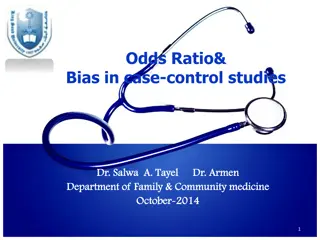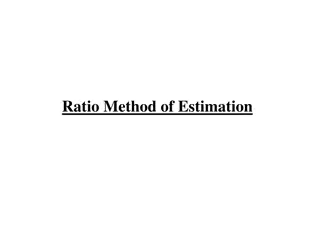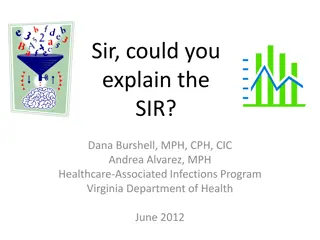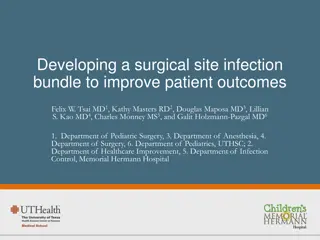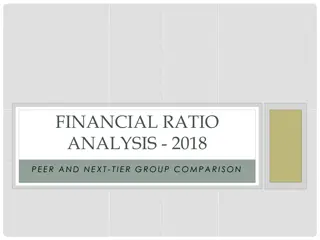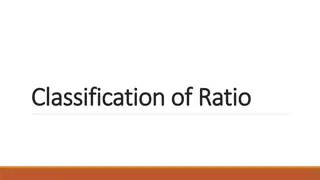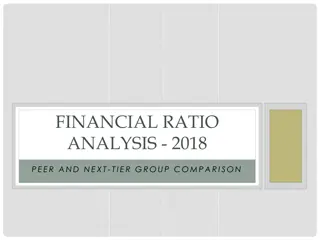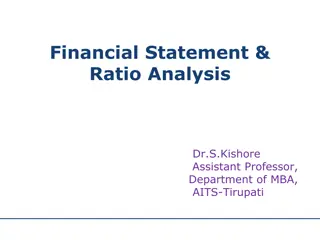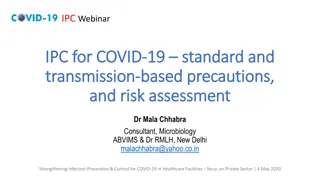Understanding Standardized Infection Ratio (SIR) in Healthcare
The Standardized Infection Ratio (SIR) is a crucial metric used to monitor Healthcare-Associated Infections (HAIs) at various levels. It allows for improved risk adjustment and comparison by providing a single summary number. Standardization methods like direct and indirect standardization help in adjusting rates based on different populations. SIR and Standardized Utilization Ratio (SUR) assist in replacing risk-stratified HAI and device utilization rates with observed and expected events, respectively. Calculating SIR and SUR enables better tracking and comparison of infection and utilization rates over time, making it easier for stakeholders to understand and discuss different healthcare metrics.
Download Presentation

Please find below an Image/Link to download the presentation.
The content on the website is provided AS IS for your information and personal use only. It may not be sold, licensed, or shared on other websites without obtaining consent from the author. Download presentation by click this link. If you encounter any issues during the download, it is possible that the publisher has removed the file from their server.
E N D
Presentation Transcript
Standardized Infection Ratio 1
Topics Standardization Standardized infection ratio (SIR) Standardized utilization ratio (SUR) Examples Example of SIR SSI SIR MOH CLABSI SIR/SUR New SSI SIR 2
Standardization Standardization refers to methods of adjustment based on weighted averages Direct Standardization Indirect Standardization Specific rates of the study population Specific rates of the standard population Requirement Uncommonly used Commonly used Use Calculating age and sex adjusted rates of infection in a study (adjusted to 2010 US population) Standardized mortality ratio of a population compare with overall US mortality rates Example 3
Standardized infection ratio Standardized utilization ratio 4
Standardized infection ratio The standardized infection ratio (SIR) is a summary measure used to track HAIs at a national, state, or local level over time. SIR provides improved risk adjustment and replace risk-stratified HAI rates. Observed HAI events Expected HAI events HAI SIR= 5
Standardized Utilization Ratio The standardized utilization ratio (SUR) is a summary measure used to track DUR at a national, state, or local level over time. SUR provides improved risk adjustment and replace risk-stratified DUR rates. Observed device days Expected device days HAI SUR= 6
Advantages of SIR Single summary metric One number that can be used to make comparisons Risk-adjusted Adjusts for factors known to be associated with differences in HAI rates Scalable Can be calculated at national, regional, facility-wide, location-specific, by surgeon for SSIs, etc. Easy understood An easier measure to discuss among internal and external stakeholders 8
SIR-Calculation and interpretation notes The SIRs calculated by NHSN use 2006-2008 as the baseline period, & therefore, SIRs are calculated for 2009 and forward. To allow for more precise comparisons, SIRs are calculated only if the number of expected HAIs is 1 When the expected HAI <1, this indicates that the denominator (e.g. number of device days or procedures ) in the facility or location is too low to calculate a precise SIR and comparative statistics. 9
SIR-Calculation and interpretation notes When this is the case, you may wish to group your SIRs by a longer time period, such as year Remove from your data any rates that had no corresponding published NHSN rates Interpretation: SIR<1 means that after adjusting for differences, fewer HAIs were observed than predicted SIR>1 means that after adjusting for differences, more HAIs were observed than predicted SIR=1 means that after adjusting for differences, Same HAIs were observed as predicted 10
CLABSI SIR 11
CLABSI SIR-Calculation CALBSI events Expected CLABSI Type of ICU CL days Hospital rates NHSN rates Medical cardiac 2 380 Medical 1 257 Medical surgical 3 627 Neurosurgical 2 712 Total 8 1976 12
CLABSI SIR-Calculation CALBSI events Expected CLABSI Type of ICU CL days Hospital rates NHSN rates Medical cardiac 2 380 5.26 Medical 1 257 3.89 Medical surgical 3 627 4.78 Neurosurgical 2 712 2.81 Total 8 1976 4.05 Hospital CLABSI rate = CLABSI events x 1000 = 2 x1000 = 5.26 CL days 380 13
CLABSI SIR-Calculation CALBSI events Expected CLABSI Type of ICU CL days Hospital rates NHSN rates Medical cardiac 2 380 5.26 2.0 Medical 1 257 3.89 2.6 Medical surgical 3 627 4.78 1.5 Neurosurgical 2 712 2.81 2.5 Total 8 1976 4.05 Published NHSN reports 15
CLABSI SIR-Calculation CALBSI events Expected CLABSI Type of ICU CL days Hospital rates NHSN rates Medical cardiac 2 380 5.26 2.0 0.76 Medical 1 257 3.89 2.6 0.67 Medical surgical 3 627 4.78 1.5 0.94 Neurosurgical 2 712 2.81 2.5 1.78 Total 8 1976 4.05 Predicted CLABSI (#) = CL days x NHSN CLABSI rate = 380 x 2.0 = 0.76 1000 1000 16
CLABSI SIR-Calculation CALBSI events Expected CLABSI Type of ICU CL days Hospital rates NHSN rates Medical cardiac 2 380 5.26 2.0 0.76 Medical 1 257 3.89 2.6 0.67 Medical surgical 3 627 4.78 1.5 0.94 Neurosurgical 2 712 2.81 2.5 1.78 Total 8 1976 4.05 4.15 17
CLABSI SIR-Calculation CALBSI events Expected CLABSI Type of ICU CL days Hospital rates NHSN rates Medical cardiac 2 380 5.26 2.0 0.76 Medical 1 257 3.89 2.6 0.67 Medical surgical 3 627 4.78 1.5 0.94 Neurosurgical 2 712 2.81 2.5 1.78 Total 8 1976 4.05 4.15 CALBSI SIR = Expected CLABSI = Observed CLABSI 4.15 8 = 1.93 18
CLABSI SIR-Interpretation Facility name CLABSI Central line days Predicted CLABSI SIR SIR p- value SIR 95% CI KAMC 8 1,976 4.15 1.93 0.06 0.83, 3.80 During 2009, there were 8 CLABSIs identified and 1,976 central line days observed in ICUs of KAMC. Based on the NHSN 2006-2008 baseline data and the composition of locations in KAMC, 4.15 CLABSIs were predicted. This results in an SIR of 1.93 (O/P= 8/4.15), signifying that during this time period, KAMC identified 93% more CLABSIs than predicted. The p-value (0.06) and 95% confidence interval (CI) (0.83, 3.80) indicate that the number of observed CLABSIs is not statistically significantly higher than the number of predicted CLABSIs. (Reminder: If the p-value is less than 0.05 and the 95% CI does not cross 1, the SIR is statistically significantly different than 1.)
SSI SIR 23
Indirect Standardization (SSI-CABG) KAMC JEDDAH KAMC RIYADH Number of surgeries Number of SSI Rate Number of surgeries Number of SSI Rate 1154 30 2.6% 1154 30 2.6% 24
Indirect Standardization (SSI-CABG) KAMC JEDDAH KAMC RIYADH Number of surgeries Number of SSI Rate Number of surgeries Number of SSI Rate 1154 30 2.6% 1154 30 2.6% NHSN Published Rates for CABG Risk index category 0 1 2 Total Pooled mean 0.35 2.55 4.28 2.94 25
Indirect Standardization (SSI-CABG) Crude infection rate 26
Indirect Standardization (SSI-CABG) Risk index CABG NHSN rate (R) KAMC JEDDAH KAMC RIYADH Number of surgeries (n1) 3 Observed SSI Expected SSI (RXn1) Number of surgeries (n2) 500 Observed SSI Expected SSI (RXn2) 0 0.35 1 2.55 950 500 2 4.28 201 154 2.94 1154 30 1154 30 Total 27
Indirect Standardization (SSI-CABG) Risk index CABG NHSN rate (R) KAMC JEDDAH KAMC RIYADH Number of surgeries (n1) 3 Observed SSI Expected SSI (RXn1) Number of surgeries (n2) 500 Observed SSI Expected SSI (RXn2) 0 0.35 0.0 1.8 1 2.55 950 24.2 500 12.8 2 4.28 201 8.6 154 6.6 2.94 1154 30 32.8 1154 30 21.1 Total 28
Indirect Standardization (SSI-CABG) Risk index CABG NHSN rate (R) KAMC JEDDAH KAMC RIYADH Number of surgeries (n1) 1154 Observed SSI Expected SSI (RXn1) Number of surgeries (n2) 1154 Observed SSI Expected SSI (RXn2) 2.94 30 32.8 30 21.1 Total Observed number of SSIs SIR = multiplier Expected number of SSIs KAMC JEDDAH SMR = 30/32.8 = 0.91 = 91 % KAMC RIYADH SMR = 30/21.1 = 1.42 = 142 % 9 % less 42 % more 29
Indirect Standardization (SSI-CABG) Crude infection rate Standardized infection rate 30
Expected CLABSI events = MOH CL days x NHSN CLABSI rate 1000 34
Deriving the SSI SIR Improved risk adjustment No longer based on the basic risk index Therefore, recent risk-stratified SSI rates not published New method uses an improved risk adjustment calculated through logistic regression modeling. Used for prediction of the probability of occurrence of an event by fitting data Allows specified risk factors to be considered Allows risk factors to be procedure-specific Allows each factor s contribution to vary according to its association with risk
Using logistic regression model to calculate SSI risk for 1 hypothetical patient Risk Factor* (X1-X4) Parameter Estimate ( 1 4) Odds Ratio p-value Intercept -5.448 --- --- Age ( 44* vs >44) 0.520 1.659 <0.001 ASA (3/4/5* vs 1/2) 0.425 1.529 0.041 Duration (>100 mins* vs 100 mins) 0.501 1.650 0.002 Med school affiliation (Y*/N) 1.069 2.912 <0.001 Hypothetical patient: 40 years old, ASA score of 4, duration of 117 minutes, medical school affiliated logit (p) = + 1X1 + 2X2 + 3X3 + 4X4 logit (p) = -5.448 + 0.520(1*) + 0.425(1*) + 0.501(1*) + 1.069(1*) = 0.05 (individual patient s risk) *For these risk factors, if present = 1; if not = 0
SSI SIR incorporating many patients Patient Age ASA score Duration Medical school affiliation SSI Probability of SSI observed 1 40 4 117 Y 0 0.050 2 53 2 95 N 0 0.004 3 30 2 107 Y 1 0.033 . . . . . . . 100 37 4 128 Y 1 0.050 Total --- --- --- --- 3 2.91 SIR = number of observed SSIs = 3 = 1.03 number of predicted SSIs 2.91 * Does not include all risk factors for SSIs
Thanks ! 44





